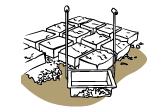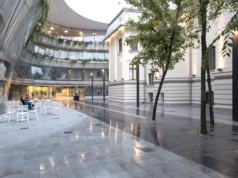
Mud brick and adobe are two other types of wall materials that are making a resurgence as alternative building materials.
What is mud brick or adobe?
Mud brick (also known as adobe) is a natural building material made by shaping bricks out of a mixture of sand, mud and/or clay with water and some fibrous organic matter (like hay, straw, sticks or manure). The bricks are usually cast in a frame to ensure that they’re a consistent size and shape. Once they have been cast, the bricks are then air-dried for up to a month. Mud brick buildings have a low resistance to water, so some manufacturers add bitumen into the mud mixture to help with waterproofing. Mud brick and adobe are some of the oldest building materials known, with evidence of mud brick buildings having been used since 7000BC.

Why install mud brick walls?
Homes made from mud brick and adobe look and feel organic and earthy, reflecting the material they are made from. A thickly built mud brick or adobe wall can be load bearing and even support a second storey. The thermal mass created by the thick walls absorbs solar energy during the day and releases it slowly at night, reducing the need for artificial heating and cooling. Mud bricks are fire resistant, cheap, sustainable and biodegradable.
On the downside, they are not the most durable of building materials, nor do they provide much insulation from cold weather. Although bitumen can be added to the mud mixture to help with waterproofing, some feel it can disrupt the ‘health’ of your building by releasing toxic fumes into the air. Unless the building is specially designed, mud brick walls are not suitable for areas at risk of earthquake.
How is mud brick installed?
Mud bricks can be purchased pre-made. To make walls out of your own home-made mud bricks though, you would ideally first choose a building site which has access to good mud. A solid foundation has to be laid on packed ground. The density of mud brick makes it a heavier building material than most, and the walls will crack if the foundation sags.
Care must be taken when preparing the mixture, as bricks with rocks and air bubbles will quickly crack and break. Once the mixture is made, the bricks are cast into wooden frames and dried. Bricks will also break if they haven’t been dried thoroughly before they are used. Although bricks can be any size and density, relatively small bricks are easier to lift and build with. The walls are then built using standard masonry techniques. Exterior walls can be rendered and extra insulation added for additional comfort.
Many people who have mud brick houses have built them by hand, but if you’re serious about a mud brick house you may want to consider consulting a specialist to ensure that you’re completely aware of what’s involved.
Maintenance
Air-dried mud bricks have a lifespan of approximately 30 years before they crumble and need to be replaced. This can be extended if your exterior walls are rendered and your house has a solid roof with deep eaves, though. Entire cities have survived hundreds of years by continuously repairing decomposing mud brick walls.
|
Advantages
|
Disadvantages
|





